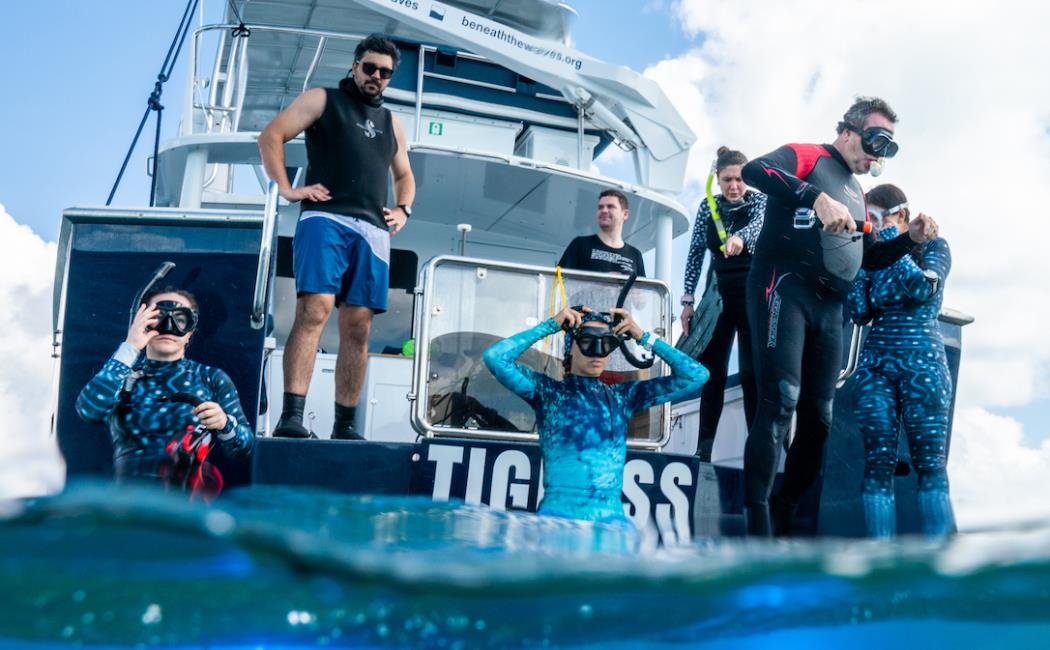
23 May, 2022
A RSRC / KAUST INSIGHT ARTICLE
A cross-disciplinary marine expedition aims to characterize an extensive seagrass ecosystem in the Bahamas. Photography: Wilson Hayes 2021
A grass meadow with the sound of chattering fish rather than the tweeting of birds, and where you’re more likely to meet a hunting shark than grazing farm animals? Welcome to seagrass meadows – ecologically complex marine environments that are as important for supporting biodiversity as coral reefs.
In November 2021, a team of researchers from KAUST, in collaboration with the US-based Beneath the Waves organization, spent a week on a boat off the coast of Great Exuma in the Bahamas. While the team is more at home in the Red Sea, this trip had an important goal: to characterize in detail the seagrass ecosystem of the Bahamas Banks for the first time. The data collected forms part of a wider project aiming to gain UNESCO World Heritage Site status for the region.
Three of the crew were KAUST Ph.D. candidates, Sofia Frappi, Michelle-Nicole Havlik and Elisa Laiolo, who are studying under the supervision of KAUST faculty member and marine expert Carlos Duarte. The Bahamas trip stemmed from an earlier collaboration between Duarte and shark researcher and Beneath the Waves founder Austin Gallagher.
“The Bahamas hosts one of the largest shark sanctuaries in the world, making it a brilliant place to study these creatures,” says Frappi. “Duarte and Gallagher had the smart idea of using sharks as interns, tagging them with cameras to observe their preferred haunts. Their data highlighted a previously unknown vast seagrass meadow off the coast of Exuma Cay, which is now the largest known seagrass meadow in the world. We plan to demonstrate just how vital these ecosystems are globally, especially for apex predators like sharks.”
“We plan to demonstrate just how vital these ecosystems are globally, especially for apex predators like sharks.”
The cross-disciplinary team used a wide variety of methods to gather extensive data during the trip, and while each team member had a specific project, everyone supported data collection and helped solve problems.
“Extensive data is needed for characterizing an ecosystem,” says Laiolo. “We needed data about everything in this ecosystem, from megafauna down to the smallest microbes and assessment of carbon stocks. Using alternative novel approaches also provides fascinating details that might otherwise be overlooked.”
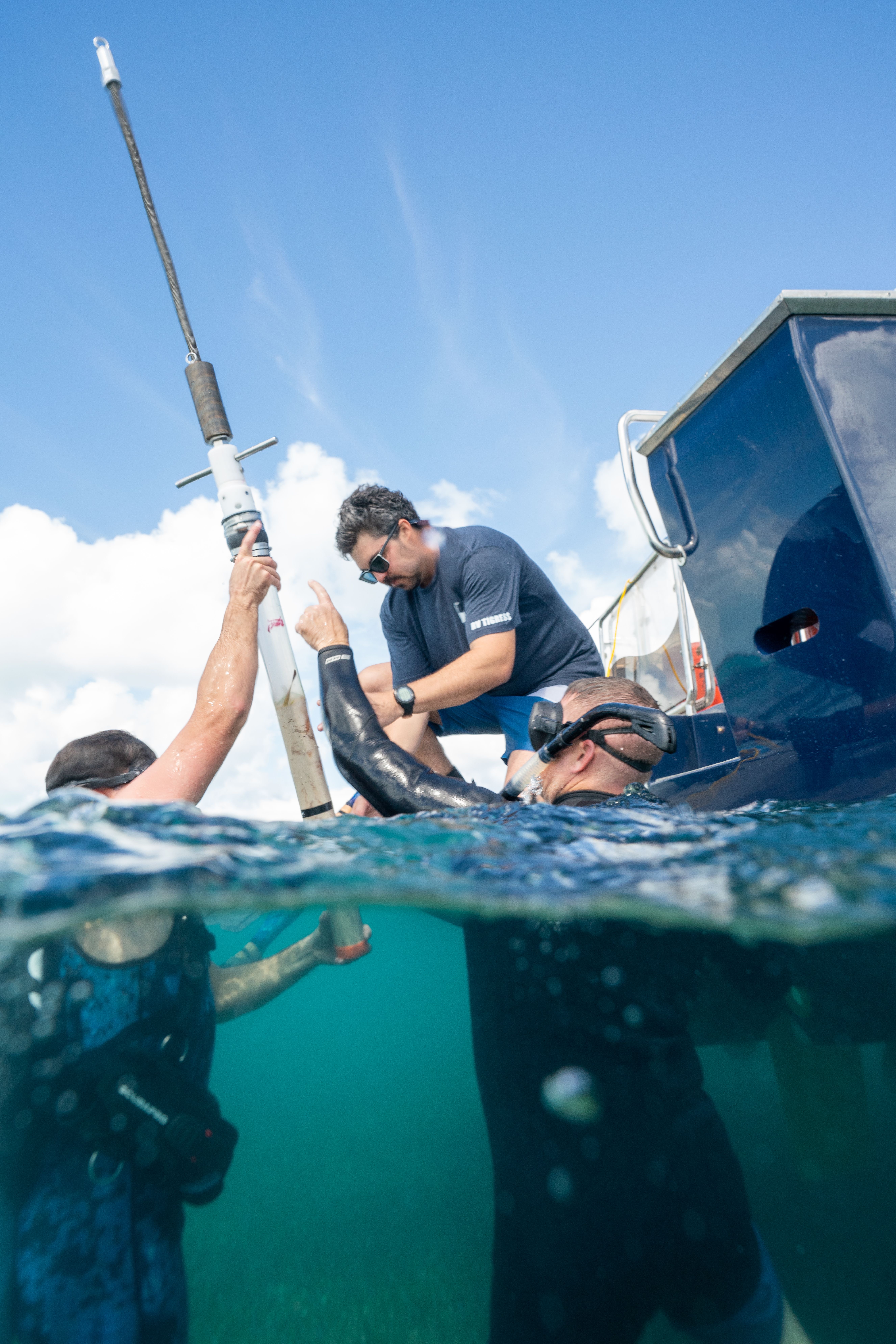
Havlik’s Ph.D. involves using hydrophones to gather data on the soundscape of seagrass meadows. “Working with experienced team members was invaluable,” says Havlik. “For example, the Beneath the Waves team suggested I place a hydrophone on one of their real-time receivers, which pings their mobile phones whenever a tagged shark passes it. This meant I could directly link specific sound traces with the presence of individual sharks.”
“Plus, combining your expertise with different perspectives for common goals is so rewarding. Not to mention the help you get when something goes wrong,” adds Havlik.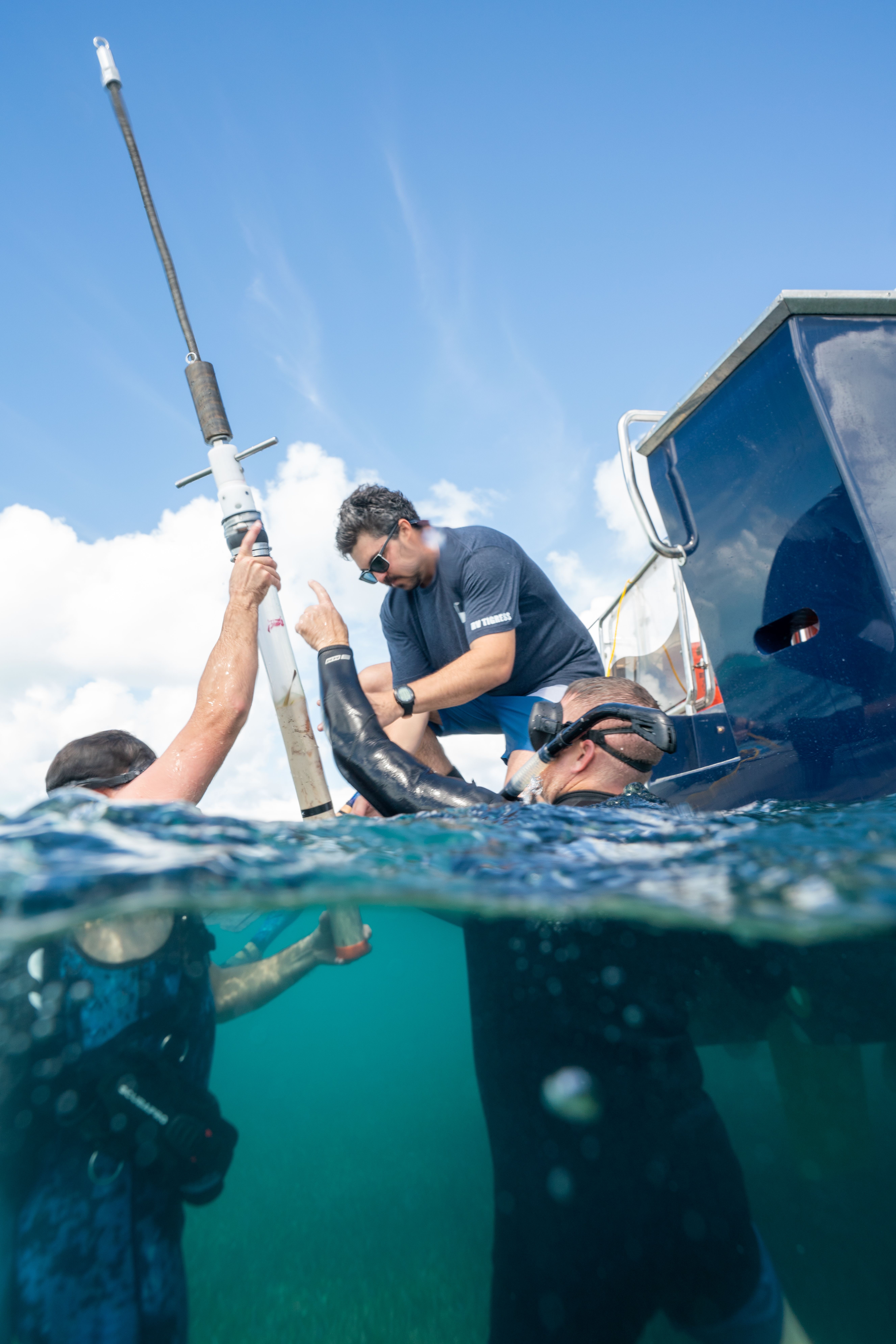
A key focus of the trip was to collect sediment cores from the meadow. The seafloor sediments build up in layers that relate to specific years, with lead-210 dating used to determine exactly when each layer was deposited. These sediment cores hold far more than “just” sand and carbonate. They contain copious amounts of environmental DNA (eDNA), which is derived from the fragments of skin and other deposits from the individual creatures that live on or use the meadow over time.
“We had to hammer long cores down into the sediments underwater and then remove the material with the layers intact,” says Sofia Frappi. “We collected one beautiful core but, no matter what we did, the three of us could not remove it from the tube; it was stuck fast. Eventually, someone took a circular saw to the plastic, saving our hard-earned core.”
Using eDNA to monitor marine creatures could revolutionize understanding of different species and their relationships, including predator-prey dynamics. Frappi is collecting eDNA to map elasmobranchs biodiversity and potentially acquire information on shark-prey interactions. She intends to use a similar approach to collect data in the Red Sea.
“Sharks are notoriously difficult to track because telemetry is costly and time consuming. eDNA provides a rapid way of monitoring sharks over time,” says Frappi. “As apex predators, they are vital indicators of the health of an ecosystem.”
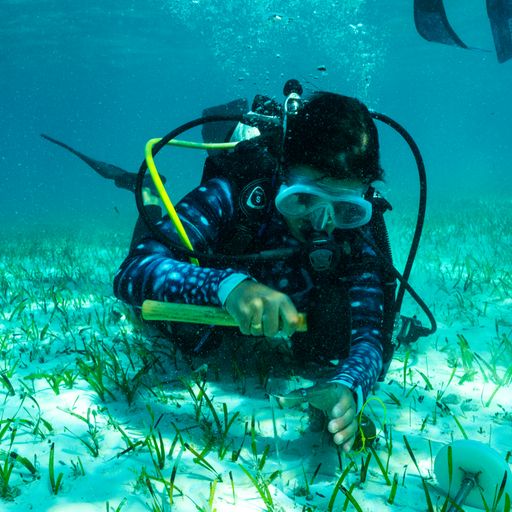
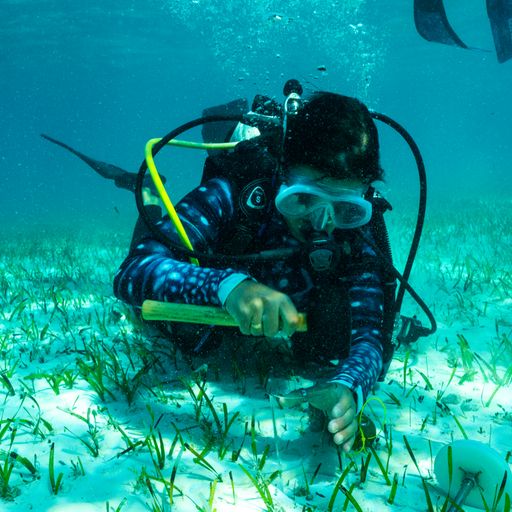
The root system of the Bahamas seagrass meadow is extensive and home to thousands of microbial communities. Seagrass meadows are “blue carbon” habitats, capable of sequestering far more carbon for far longer than scientists initially thought, but the mechanisms inherent in these ecosystems are unclear.
“This is where my Ph.D. project comes in,” says Laiolo. “I’m focusing on microbial communities, and I’m particularly interested in blue carbon habitats. Using a metagenomic approach, I study the functional traits of microbes and how these complex communities can contribute to biogeochemical cycles and processes, like carbon sequestration.”
The researchers hope to find evidence of the influence of human activity on the Bahamas seagrass ecosystem. Not just in terms of disturbance by boats and fishing, but also to discover if the seagrass meadow has revitalized since the area was designated a shark sanctuary in 2011, which built on the area’s long history of being a marine protected area. If the ecosystem’s health is shown to have improved, it will boost the chances of securing further protection for this and other regions.
If the ecosystem’s health is shown to have improved, it will boost the chances of securing further protection for this and other regions.
“Visiting the Bahamas and witnessing the good status of the ecosystems under protective measures really motivates us to demonstrate that such policies are worth pursuing,” says Laiolo.
“We must have hope and continue to push forward with finding new knowledge, new ways to collect data while suggesting ways to help protect all marine habitats,” says Havlik.
“Otherwise, no policies will change, no one will act,” adds Frappi. “We have to fully protect at least 30 percent of our oceans by 2030 so that marine life can begin to recover worldwide. We’re so proud that our work contributes to this wider goal.”
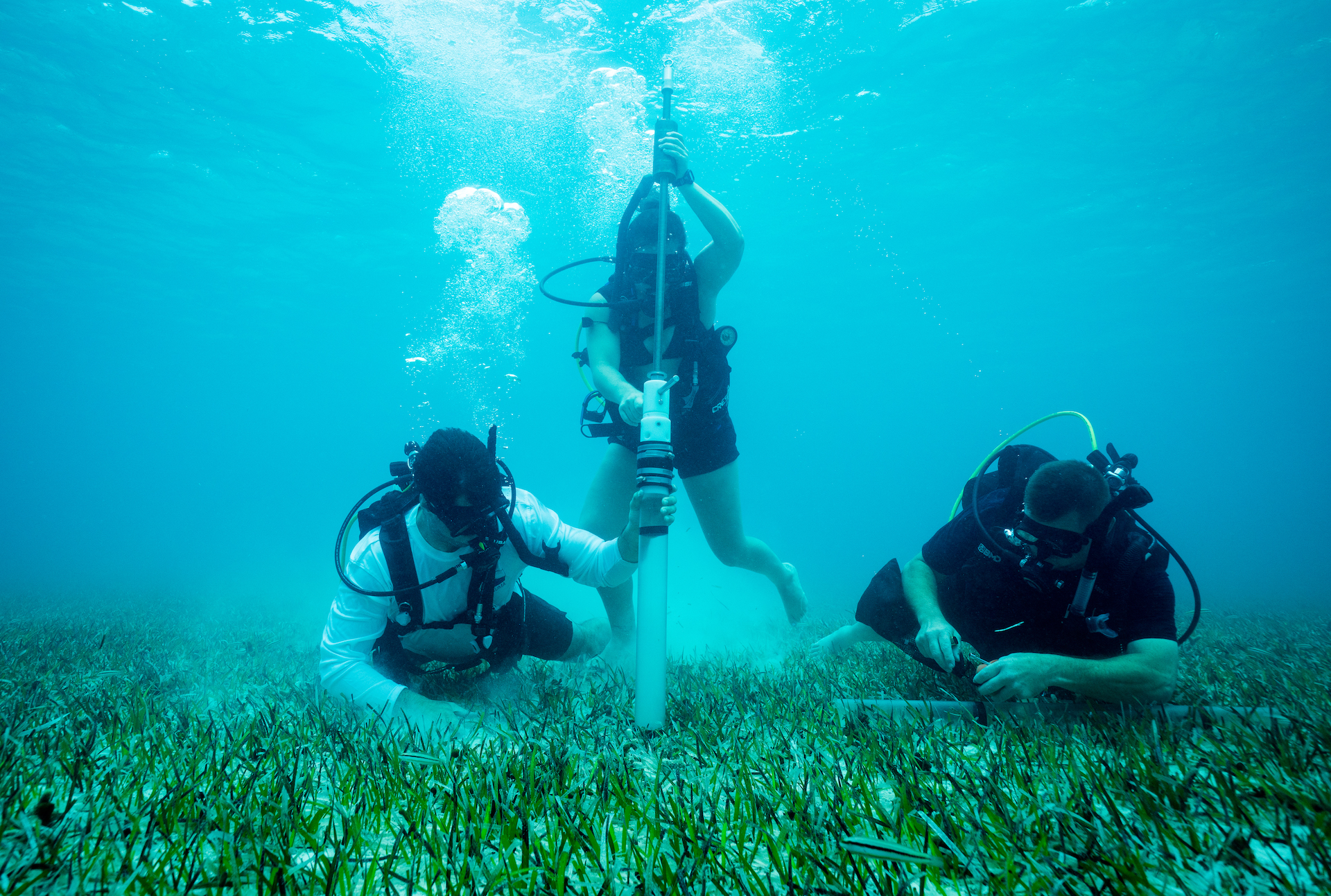
“Many people believe the ocean is a quiet place, but nothing could be further from the truth,” says Havlik. “Have you ever heard the sound of 1000s of shrimps clicking their claws together? It’s like popcorn popping! And fish chatter to each other, all day. They have dawn and dusk choruses, just like birds.”
Michelle Nicole Havlik is studying the soundscape of seagrass meadows using hydrophones, which are high precision underwater recorders that detect sounds across a large range of frequencies from all directions. This data can help determine the behaviors and movements of marine creatures over time. Hydrophones also provide invaluable detail on the influence of human activity, such as noise disturbance from boats.“
Hydrophones are a fantastic complementary characterization tool,” says Havlik. “If you incorporate hydrophone data with other information — like eDNA and microbial data from sediment cores and photographs and transect data— you can build a strong picture of how healthy a given ecosystem is.”
The soundscape of an ecosystem changes according to its health. It gets louder or quieter, or the blends of sounds will grow more complex, depending on the biodiversity and strength of the marine organisms living there. The technology can also shed light on the preferences of marine creatures, such as places they frequent or avoid because of certain sounds. “The dream is that one day we can use this technology to gauge the health of even the remotest parts of the oceans,” notes Havlik.